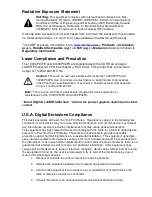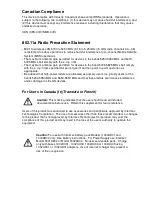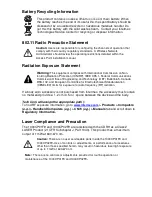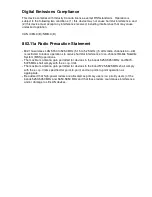
Radiation Exposure Statement
Warning:
This equipment complies with International Commission on Non-
Ionizing Radiation Protection (ICNIRP), IEEE C95.1, Federal Communications
Commission Office of Engineering and Technology (OET) Bulletin 65, Canada
RSS-102, and European Committee for Electrotechnical Standardization
(CENELEC) limits for exposure to radio frequency (RF) radiation.
If a body worn accessory is not purchased from Intermec, the accessory must contain
no metal and provide a 1.2 cm (0.5 in.) space between the device and the body.
To find RF exposure information, go to
www.intermec.com
> Products > Computers
(e.g.)
> Handheld Computers
(e.g.)
> CN70
(e.g.)
> Manuals
tab and scroll down to
Regulatory Information.
Laser Compliance and Precaution
The 1000CP01F9 and 1000CP02F9
are registered with the CDRH as a Class 2
LASER Product (21 CFR Subchapter J, Part 1040). This product has a maximum
output of 1 mW at 630-670 nm.
Caution:
There are no user serviceable parts inside the 1000CP01F9 and
1000CP02F9
.
Use of controls or adjustments, or performance of procedures
other than those specified herein, may result in hazardous laser light exposure
of up to 1 mW at 630-670 nm.
Note:
There are no controls or adjustments provided for routine operation or
maintenance of the 1000CP01F9 and 1000CP02F9
.
*Insert English LASER label here *
Contact the product graphics department for label
content.
U.S.A. Digital Emissions Compliance
This device complies with part 15 of the FCC Rules. Operation is subject to the following two
conditions: (1) this device may not cause harmful interference, and (2) this device must accept
any interference received, including interference that may cause undesired operation.
This equipment has been tested and found to comply with the limits for a Class B digital device,
pursuant to Part 15 of the FCC Rules. These limits are designed to provide reasonable
protection against harmful interference in a residential installation. This equipment generates,
uses, and can radiate radio frequency energy and, if not installed and used in accordance with
the instructions, may cause harmful interference to radio communications. However, there is no
guarantee that interference will not occur in a particular installation. If this equipment does
cause harmful interference to radio or television reception, which can be determined by turning
the equipment off and
on, the user is encouraged to try to correct the interference by one or
more of the following measures:
1. Reorient or relocate the radio or television receiving antenna.
2. Increase the separation between the computer equipment and receiver.
3. Connect the equipment into an outlet on a circuit different from that to which the
radio or television receiver is connected.
4. Consult the dealer or an experienced radio television technician for help.























